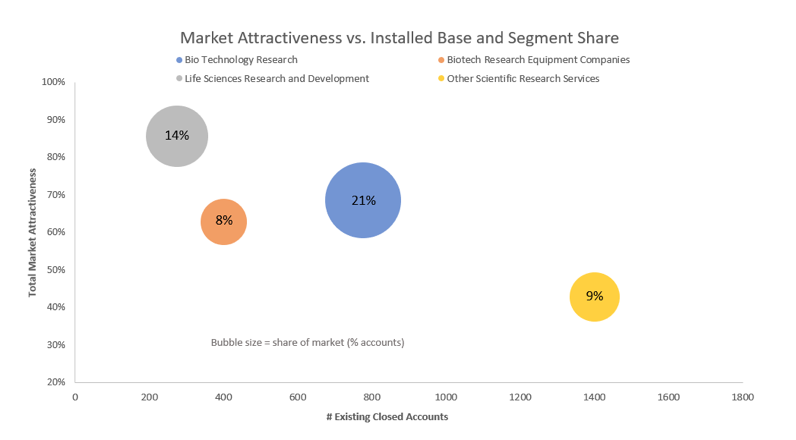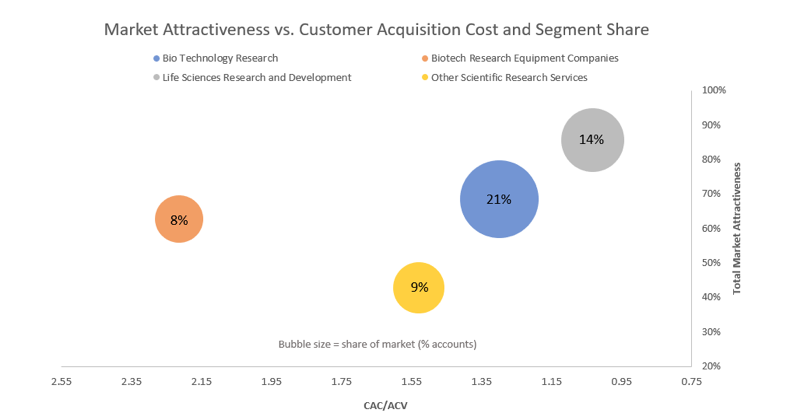CEO Blog - Advice for CEOs on growth and scaling
Finding the Sweet Spot in B2B Markets

Narrowing Focus to Drive Demand
In a prior blog post, I discussed how a lack of market focus can lead to poor marketing campaign conversion rates.
That post looked at five leading indicators to test whether a tighter focus can help. If you’ve decided that you are ready to move to a more focused approach, let’s now set about the task of identifying and prioritizing sweet spots. This will allow you to develop markets, and to create new demand that drives up close rates over time.
Teams often struggle to make market-focused decisions, as a result of three prevailing factors:
- Insufficient facts to make decisions about focus
- The available facts are unsuitable to drive an actionable plan
- The organization has the momentum to invest only in areas that produce ready-to-buy opportunities, regardless of source.
I’ll cover the last issue in a separate post to follow. For now, I’ll focus on an approach that I’ve found useful for decision-making and prioritizing target markets for development.
First, let’s understand how demand is quantified in B2B markets. Demand exists when buyers recognize an urgency to solve problems and consider what solution categories might help them. Next, they begin to develop a shortlist of potential solution providers, talking to peers and teams along the way to elicit feedback. From this information, a picture of what they truly need emerges. But here’s the rub: For those of us hoping to provide the solution, a prospect that is still in the phase of recognizing a need is a far cry from being BANT qualified – a measure of whether the budget, authority, need, or timeline exists to qualify the lead. The need exists, but we can’t assume there is any budget for the solution. There may or may not be anyone with the authority to buy, and the timing is probably unclear. Influencers might review materials or speak with you for research. But, decision-makers at this stage are often unwilling to engage in sales conversations.
For this reason, you'll need to keep driving inbound opportunities based on existing demand, while targeting prospects via outbound demand-generation programs in parallel. Your first goal should be to discover and reinforce your targeted buyer's triggers regarding urgency and employ those to move them to action. The more prospects that are motivated to action, the higher your conversion rates tend to get. A second goal should be to establish your company and offerings as a safe choice among the "short-list" of possible solutions.
This all requires that you first identify and then prioritize self-referencing groups (segments) to target (with a particular focus on industry, geography, buyer/influencer title, size of organization, and product or service use case), and then develop laser-focused messages that are both specific and relevant to those groups. If done correctly, your focus will create word-of-mouth referrals among peer champions and influencers, who tend to amplify your messages over time.
To rank buyers to target by segment, you’ll need to answer two questions: How attractive is the market segment of interest? And, how large is the potential within that segment? Don’t confuse these two questions, though. For this purpose, an “attractive” market is not always a big one. "Attractive” means that the likelihood of eventual purchase is high. Understanding the size of the market opportunity – the pond you will fish in – is important. It's just a separate question that you can use to decide how many segments to target for development.
The likelihood of an eventual purchase (attractiveness) depends upon a combination of prospect needs, which you can research, and an honest self-assessment of how capable you are to fulfill them. For each potential target, ask yourself the following five questions, and score each segment (on a 1 to 5 scale) by summing your rankings.
- Do you have access to target buyers in the segment who have identified the problem, potential solutions, and funding?
- To what degree is the problem you are solving seen to be urgent?
- To what degree does your offering satisfy the total solution needed to capture a significant share in the segment?
- Do you have the right channel or route to market that matches how prospects buy in the segment?
- For these types of buyers, how advantaged or disadvantaged are you versus your competitors?
There are quite a few techniques that I’ve used over the years to arrive at specific rankings. In general, the absolute number assigned to any one segment is less important than being consistent about how you identify the differences between segments.
Start the process by talking with your sales team about their existing accounts, so you can better understand who the decision-makers and influencers were in their closed deals. Try to unearth the specific problems they were trying to solve, and what the implications of those problems were. Also, see if you can identify the triggers that caused buyers to realize that their problem was urgent. And, most important, ask what the implication of taking no action would have been. You should understand not only what the upside benefit of your offerings are by segment, but also what pain (cost) your customers would endure if they did not act.
I’ve found it useful to do a workshop with sales teams around these questions to get quick insights. Bear in mind that you will get filtered answers from sales reps. Sales reps may not know the purchasing journey before their initial contact. Even so, discussing specific example accounts allows you to build a hypothesis, so that you can narrow any other research or validation that you choose to do.
In immature markets, or if you are introducing disruptive innovations, weight question Nos. 1 and 2 heavily. In mature markets, weight question Nos. 3, 4, and 5 higher. In either case, a weighted average will give you a market attractiveness score. The process will also help you to identify gaps in the business that may be barriers to market adoption. For example, you may find that in one segment, urgency ranks high and prospects are well funded, but your solution is not perceived as complete. You may discover that your offerings are solid, but that your competitors win because of market domain knowledge. Answering these questions will unearth these issues, so that you can optimize your targeting where you will most likely succeed and create plans to overcome identified gaps.
When you have quantified the attractiveness of each potential target market and have analyzed the total available market in those segments using publicly available research, you can superimpose the opportunity size, as well as acquisition costs, onto your decision matrix. The example charts below illustrate. 

In the examples, we can see that life sciences R&D departments are the most ‘attractive’ (high ability to close) targets, while biotech research firms are almost as attractive, with a higher share of market penetration. This tells us that one or both may be the natural targets for focused development, depending upon their size. In this case, the underlying data shows a total available market in the two segments of 5,650 accounts, with 1,051 accounts who have already purchased once. So, the plan would be to launch efforts to increase demand among the 4,599 accounts who are not yet customers. Our plan should then lay out how we will track evidence of increased demand.
In future posts, I will lay out some examples of KPIs that you can use to measure new demand within a targeted B2B market segment. I will also address some of the organizational and change management issues that I have seen when introducing focused market development initiatives.
[1] BANT: Developed by IBM, BANT (budget, authority, need, and timing) is a widely used method of prospect qualification.
Topics: Business Growth Strategy, Sales Funnel, Demand Generation, Marketing and Sales
Fri, May 1, 2020- Press Releases
- Careers
- Case Studies
- Marketing Consultant Company
- Marketing Strategy Consultants
- Marketing Plan Consultants
- B2B Marketing Consultants
- Virtual CMO
- Marketing Consultant Outsourcing
- Fractional CMO
- What is a Fractional CMO
- Healthcare Marketing Consultant
- Marketing Consultant Houston TX Texas
- Marketing Consultant Texas TX
- Marketing Consultant Bay Area
- CEO Blog
- Ebooks Plus
- Executive Marketing Consultants
- Product Marketing Consultants
- B2C Marketing Consultants
- Virtual Marketing Consultants
- Senior Marketing Consultants
- Temporary CMO
- Hire a CMO
- Fractional CMO Salary
- Fractional CMO Responsibilities
- Marketing Consultant Austin TX Texas
- Marketing Consultant Dallas TX Texas
- Marketing Consultant San Antonio
- Helping Private Equity
- Private Equity Blog
- Leadership Team
- Privacy Policy
- Business Marketing Consultants
- Strategic Marketing Consultants
- Marketing Technology Consultants
- Sales and Marketing Consultants
- CMO Job Description
- CMO Salary
- Fractional CMO Agency
- Fractional CMO Services
- CPG Marketing Consultant
- Marketing Consultant San Diego
- Partners
Houston, TX 77056
© 2023 Chief Outsiders



